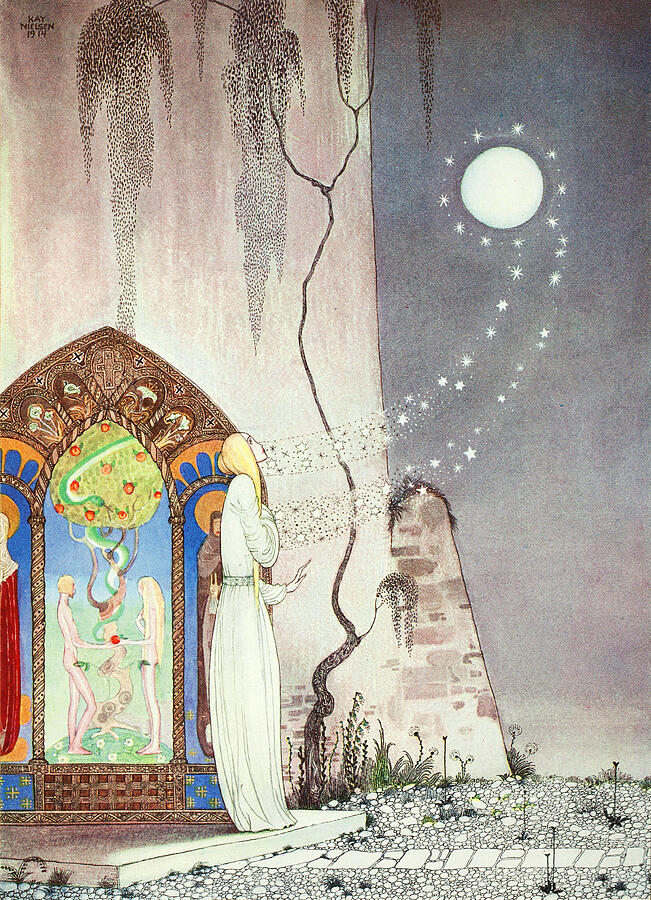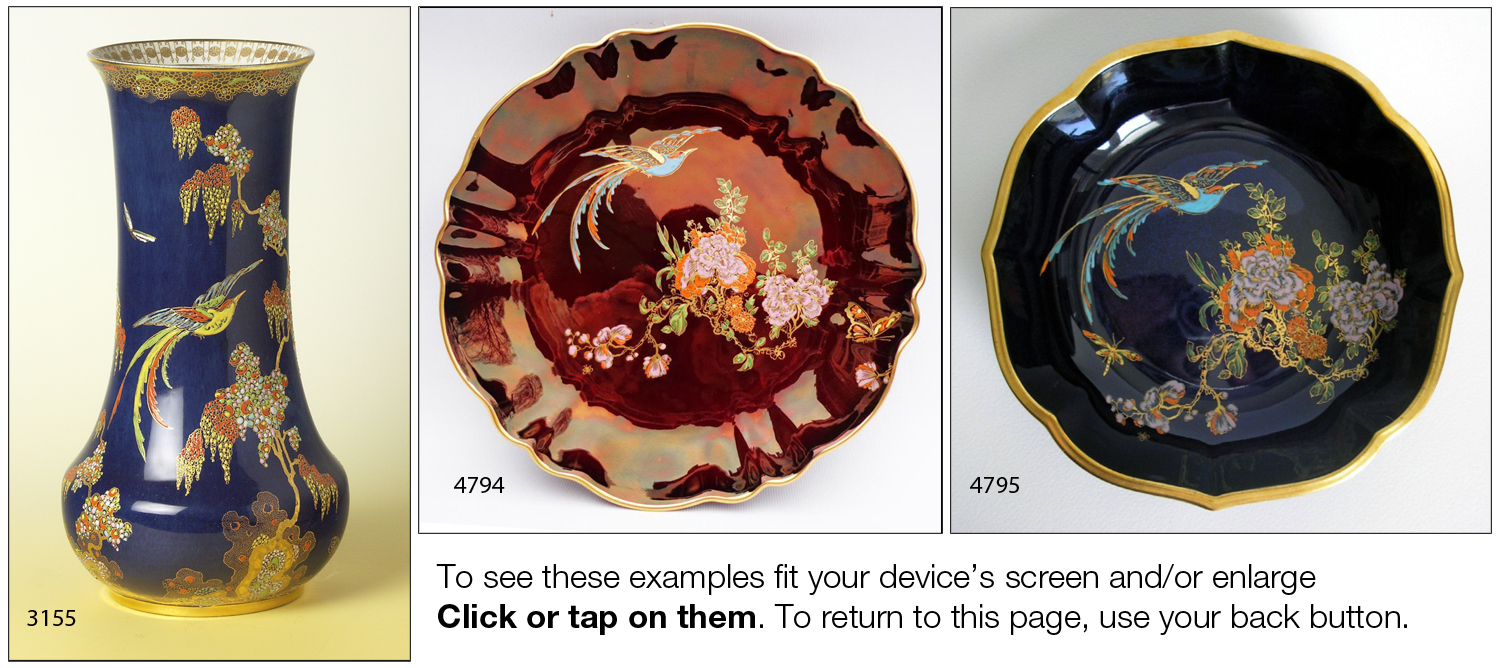Boulton's Birds - Part Ten
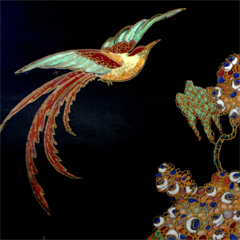
PARADISE BIRD & TREE
Designed by Enoch Boulton
by Harvey Pettitwith border artwork by Barbara Anne Lee
This is the tenth in a series of sixteen articles on bird patterns introduced by Enoch Boulton during his tenure as designer and decorating manager at the Carlton Works from 1921/22 to 1930.
Flights of Fantasy
PARADISE BIRD & TREE, along with the slightly earlier SWALLOW & CLOUD, marks the beginning of the introduction of more modern, stylised, and adventurous designs. They are flamboyant and build on the vibrant and striking ground colours that Boulton used on some of his previous patterns.
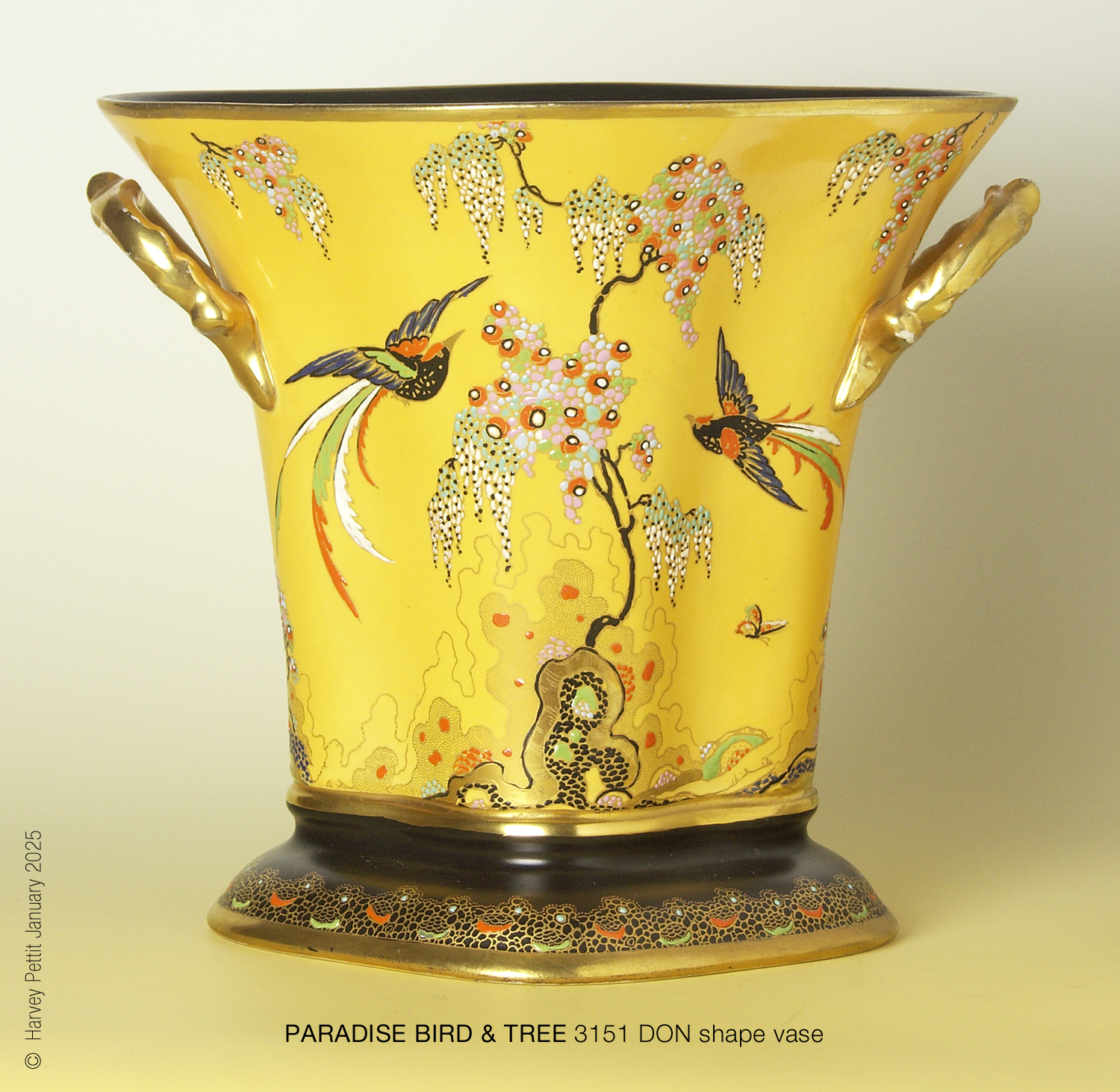
To return to this page, use your back button.
The design of the pattern was versatile in that the tree could be made to almost any height making it fit and suit the shape to which it was applied, simply by the transferers applying it in selected sections. The bowl below illustrates this well. The tree is also a perfect vehicle for the extravagant, jewel-like raised enamelling for which Carlton Ware became renowned.
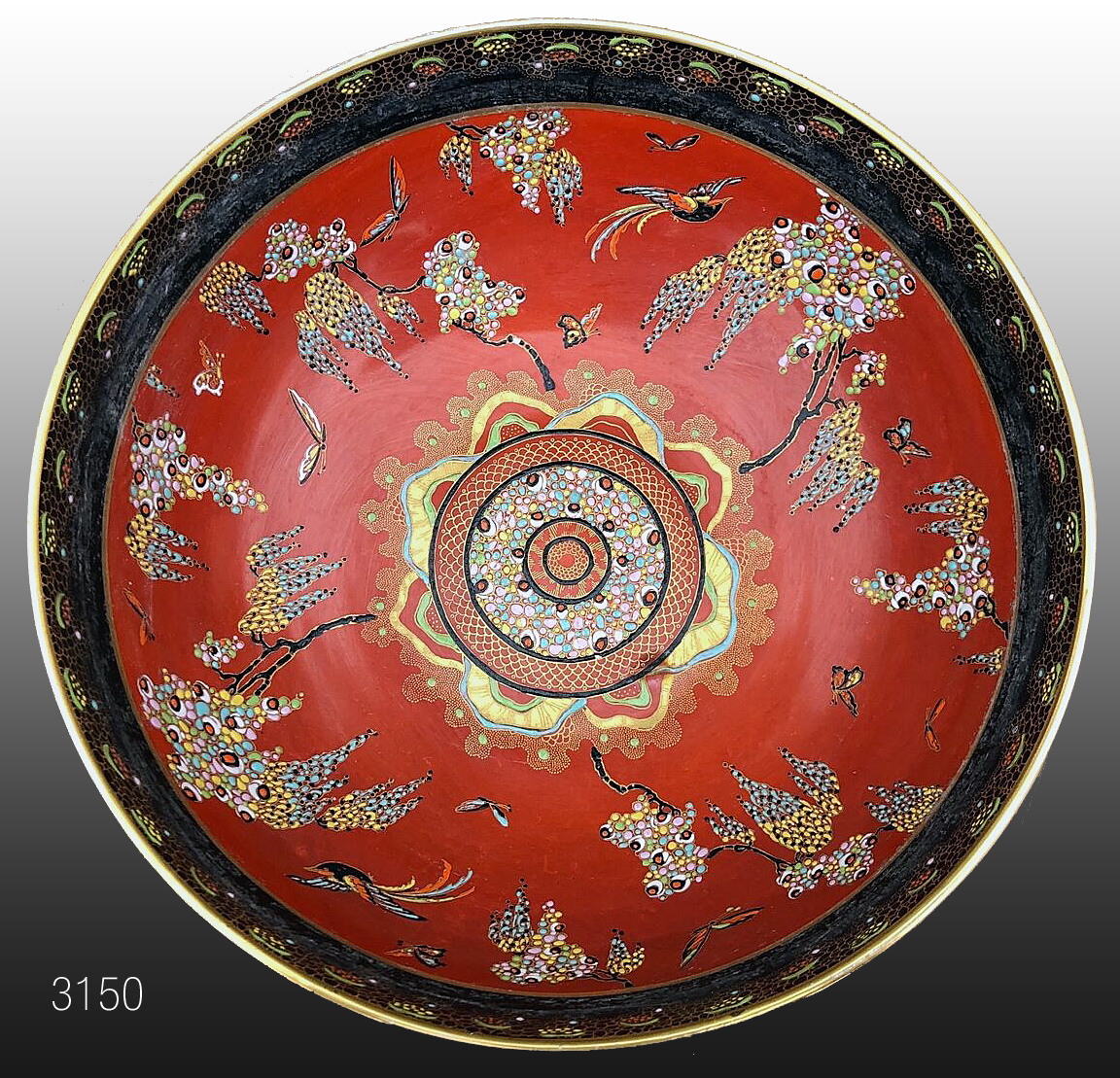
tree could be placed to fit available space. Notice the arrangement's symmetry.
To return to this page, use your back button.
The bowl centre is also elaborate and clearly designed to match the pattern.
I will write about bowl centres in a future article. The black and red ground colours on the bowl above simulate Chinese lacquer. Indeed, the colour was called RED LACQUER. The introduction of such an opulent, modern pattern must have meant that the pottery was confident and optimistic about its future.
It also suggests that the pottery had recovered from the loss of highly skilled employees as a consequence of the 1914-18 war.
Influences
The 'rocks' at the foot of the PARADISE BIRD & TREE pattern are a modern interpretation of Chinese designs featuring Gongshi, or 'scholar's rocks.'
Horace Wain, Boulton's predecessor, replicated Gongshi-featured patterns found on 16th and 17th-century Kang-Hsi and Kien-Lung porcelain. Below is part of Wain's Indian Tree Peony pattern, showing its Gongshi next to Boulton's modern interpretation of the 'rocks'. (Also, see Wain's Blue Rocks & Blossom pattern, which shows pictures of Gongshi set in a traditional Chinese garden.)
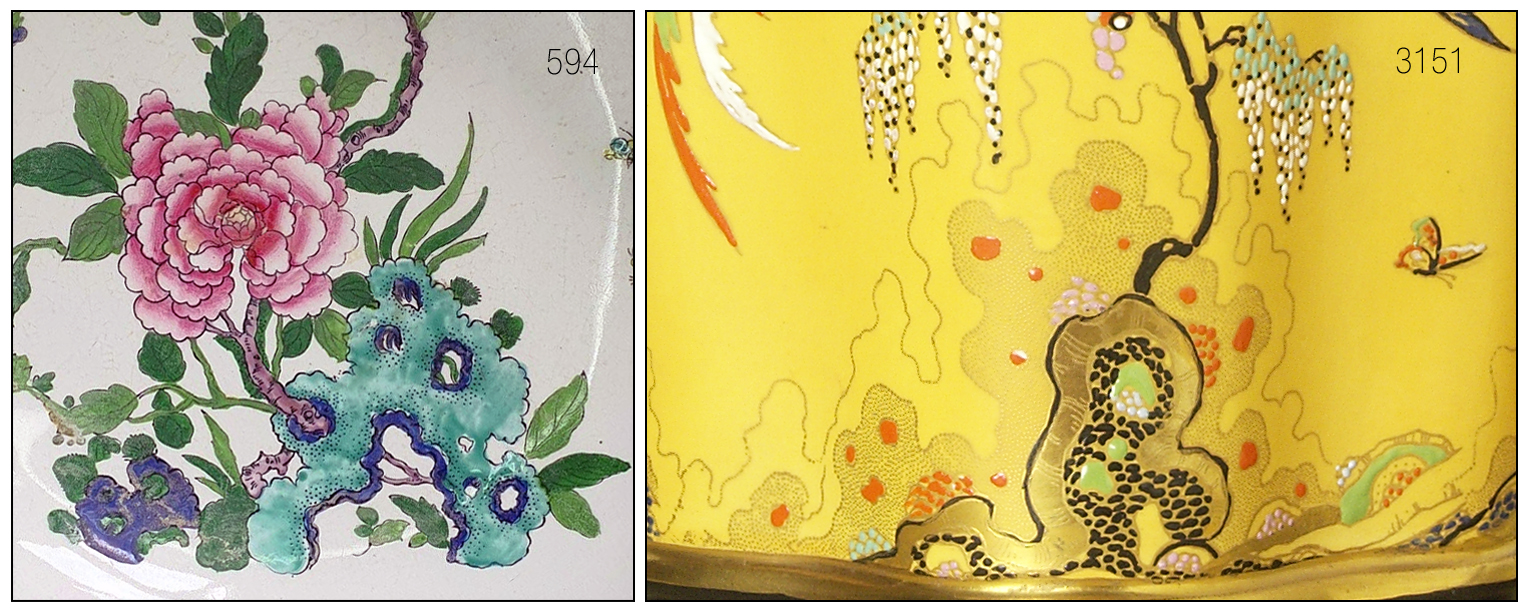
scholars rocks. Right: Enoch Boulton's stylised version of the 'rocks' on his PARADISE BIRD & TREE.
To return to this page, use your back button.
Sometimes, depending on the space available, only a tiny part of the 'rocks' was used. Two versions of Boulton's stylised Gongshi were engraved onto the pattern's copper plate: one smaller and in a different form giving flexibility to the transferers to fit either or both to a particular shape.
A significant influence on some of Boulton's later work, including this pattern, comes from early 20th-century fairy tale book illustrators such as Kay Nielsen and Harry Clarke. The picture on the right is from East of the Sun, West of the Moon, a collection of Scandinavian fairy tales, illustrated by Nielsen and published in 1914. Notice the form of the tree with its cascading foliage. It is likely that Cuthbert Wiltshaw, the owner of the pottery, had shown Boulton a copy of this book, probably bought for his four daughters, who were young children in the 1920s.
In 1930, Enoch Boulton was persuaded to move to Fieldings, makers of Crown Devon. Two or so years later, one of the patterns he devised for his new employer replicated parts of Harry Clarke's elaborate illustration titled "She Should Be Queen of the Flowers" from Fairy Tales by Hans Christian Andersen, published by George G. Harrap & Co. Ltd., London, in 1916. Fieldings called the pattern FANTAZIA giving it the pattern number 2444 that I estimate was introduced in 1932. Earlier, Violet Elmer had adapted parts of the same illustration in her Fantasia pattern (our name), which, in her own words, was one of her first earthenware patterns for the pottery. It was introduced shortly after she took over from Boulton in 1930. Perhaps Cuthbert Wiltshaw had also shown the twenty-three-year-old Miss Elmer his children's fairy tale books.
The Birds & Butterflies
The copper plate used to print the pattern included two different birds, each flying in opposite directions—you can see this in the image at the top of the page. Additionally, the creatures came in two sizes. It appears that both birds were only used on larger canvases. The exotic birds might have been inspired by the fantastical fowl found on furnishing fabrics, which Boulton appears to have simulated on his earlier CRETONNE pattern.
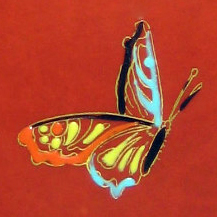
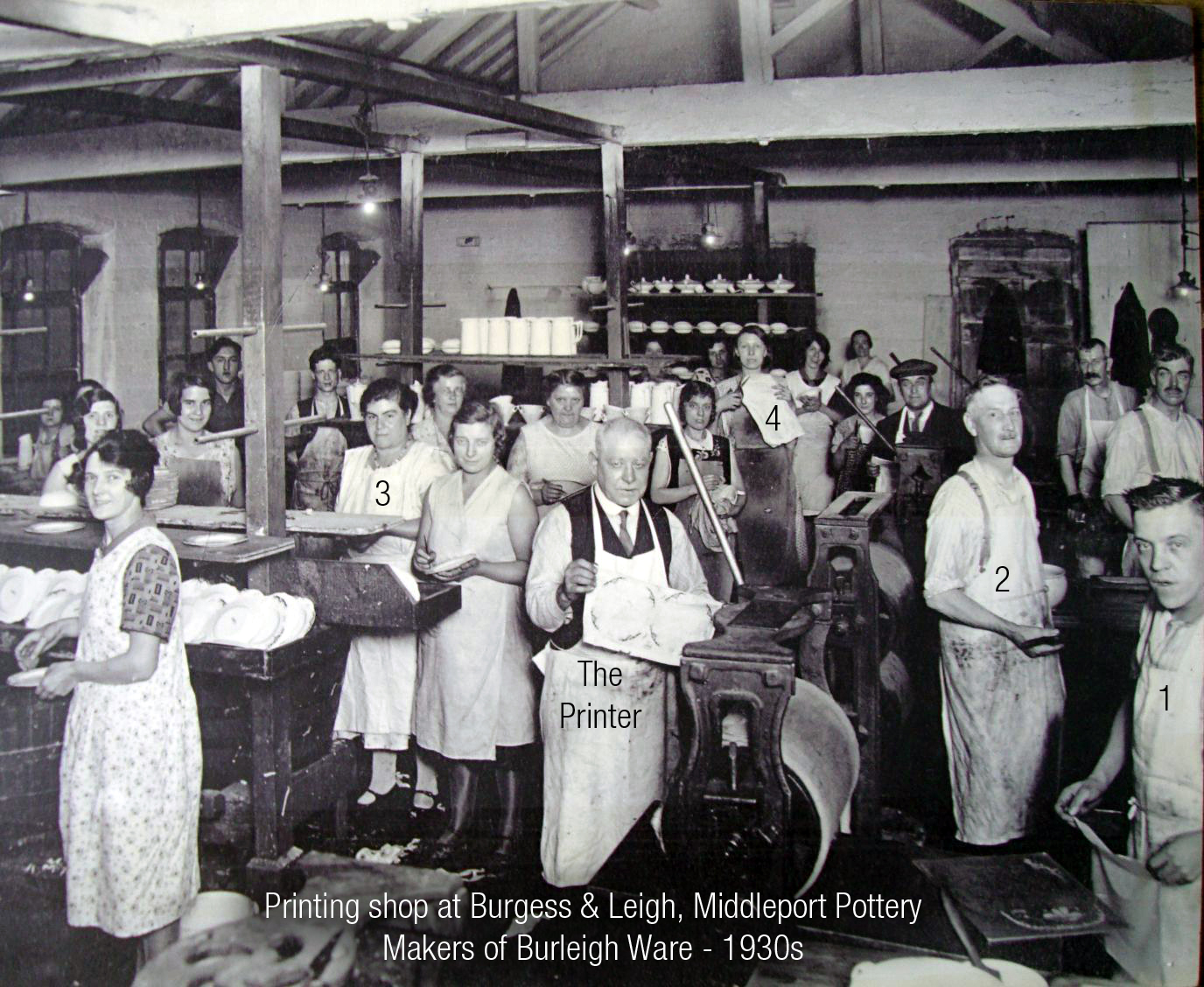
To return to this page, use your back button.
Is that a relative of Robbie Williams, bottom right (1), who looks to be placing transfer paper onto a flat copper plate ready to be passed through one of the printing machines? The singer's family hails from The Potteries.
The other printer's assistant behind 'Robbie' (2) is inking the copper plates. The transferers (3), standing at their benches, are on the left. The woman standing at the back (4) is holding a pair of scissors about to cut out a print into its required sections. Notice that the Printer at the centre of the photograph is holding up a print of a pattern for dinner or sandwhich plates and that he is wearing a waistcoat, collar and tie. In this printing shop, there are two teams; the second printer can be seen standing at the back wearing a flat cap, and near his two assistants.
PARADISE BIRD & TREE BORDER
Boulton created an abstract, lace-like border for the pattern, unlike any that preceded it. Perhaps the border, too, was inspired by Kay Nielson's work.
Barb has redrawn it for us below. To see how the border was decorated in various colours on this and several other patterns, click or tap on it.
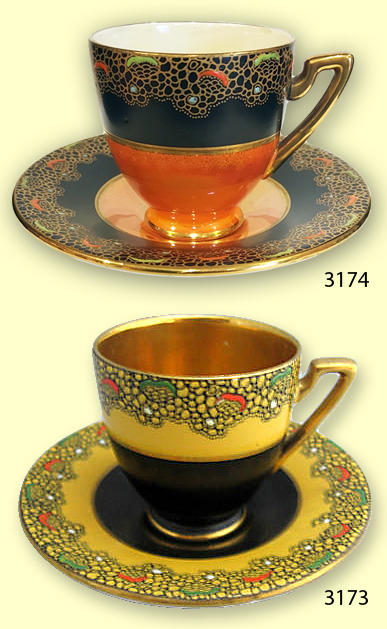
The border was used alone with great success, especially on coffee ware. On the right are two examples of PARADISE BIRD & TREE BORDER 3173 and 3174 on a MELON shape coffee cup and saucer. Variant 3173 was printed in black, 3174 in gold. Notice that one cup is white inside, and the other is gold. The more adornments a decoration had, the more expensive it had to be in the shops.
Click or tap on the cups to enlarge.
The border was also used on other patterns.
In total, there were thirteen variants of the border when used alone, most devised for coffee ware, testifying not only to the border's popularity, but also to how fashionable coffee sets had become in the interwar era.
Date of Introduction
In Carlton Ware's pattern records, PARADISE BIRD & TREE 3149 is dated July 1927, one of the few entries with a date. Consequently, we can be fairly certain that this was the year of introduction.
Availability
In total, there were 28 variants of the pattern. The first was 3147, which has a BLACK ground. The pattern may have been available into the 1950s since its sister pattern, PARADISE BIRD & TREE with CLOUD —which I write about in the next article—is found on shapes introduced after 1945, at the end of World War II. It was clearly a popular pattern, not only because of its large number of variants, but also because, after the Woods bought the pottery in 1967, they revived the bird and some of the butterflies in a gold slide-on lithograph, combining it with sprays of peonies, similar to those that Horace Wain used in his much earlier Chinosierie patterns. The new, easy-to-apply gold lithograph was made specially for the Woods by one of the many local litho manufacturers supplying the pottery industry. Lithographs were much quicker to apply than traditional printing; they required less skill and gave a flatter appearance, as noticeable on examples. After the litho was applied, it was then raised enamelled in the traditional way. This new pattern was given the similar name of BIRD OF PARADISE. Below is a comparison of the two patterns.
Notice how the RUBY LUSTRE example above appears more reflective than the pre-war version after its re-formulation during World War II for the ROUGE ROYALE decorations. Also, notice that the BIRD OF PARADISE patterns do not have borders. Shortly after buying the pottery in 1967, the Woods sold off all the copper plates from which patterns and borders were printed—for scrap!
The time-honoured method of printing and enamelling had become too expensive and had seen its day. Understandably, the new owners were not prepared to go to the extra expense of commissioning lithographs of borders. The absence of a border on examples using RUBY LUSTRE and POWDER BLUE grounds is an indication that it was made after World War II, particularly during the Woods' ownership of the Carlton Works from 1967 to 1989.
Desk Pen Stands
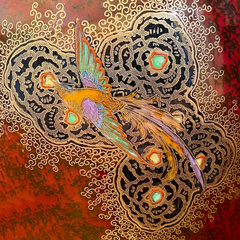
with CLOUD.
According to Carlton Ware's pattern records, the last five of the twenty-eight variants of PARADISE BIRD & TREE were devised specifically for desk pen stands. These are 3310, 3311, 3312, 3315, and finally 3317. Unfortunately, I do not have examples with these pattern numbers to show you. However, I will show desk pen stands decorated with the sister pattern PARADISE BIRD & TREE with CLOUD, which is the subject of my next article. Besides, this article may already be too long! Well done, if you have reached the end.
Harvey Pettit, February 2025.
Thanks must go to Chris Rutter for helping out with the images of coffee cups and saucers.
V1 February 2025. If more accurate information comes to light, I will update this page.

